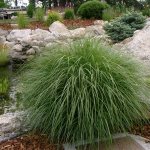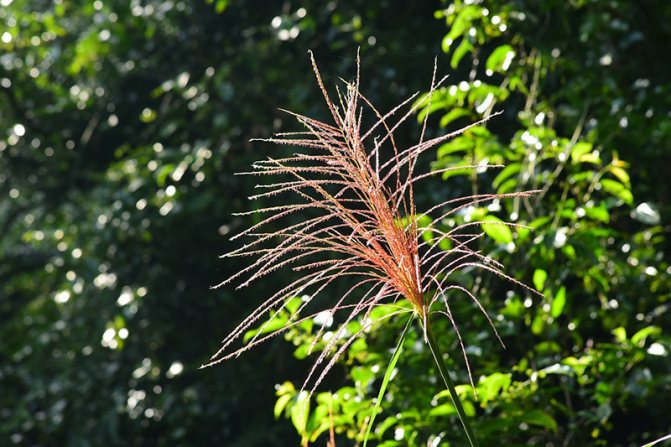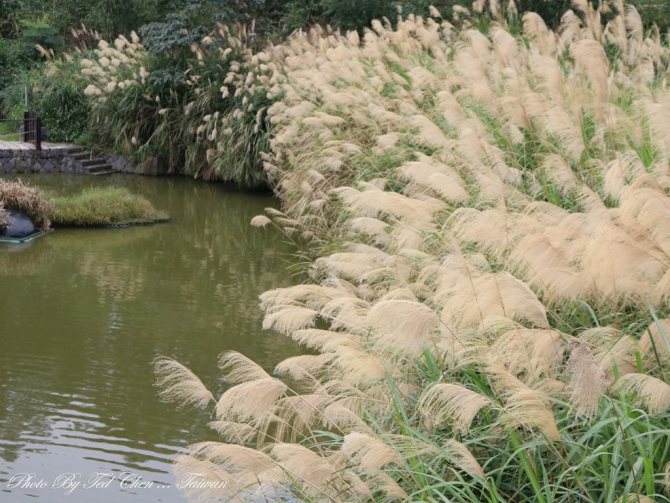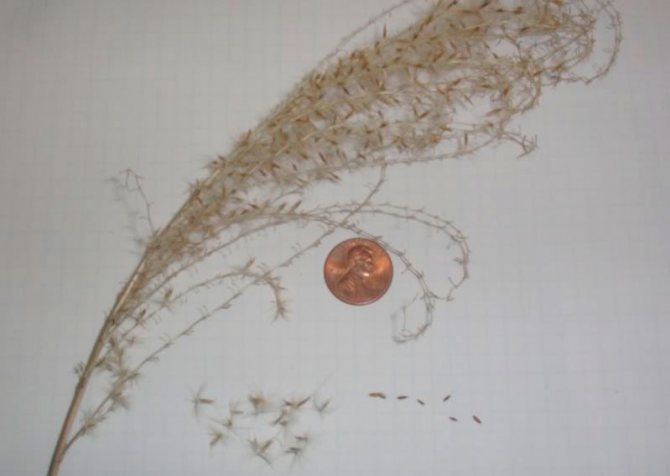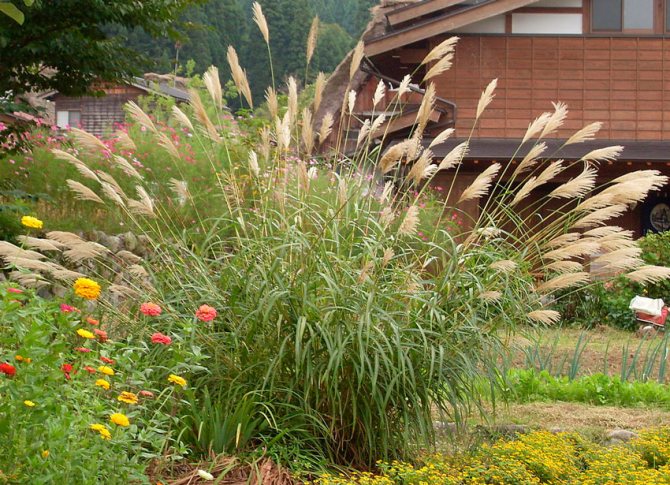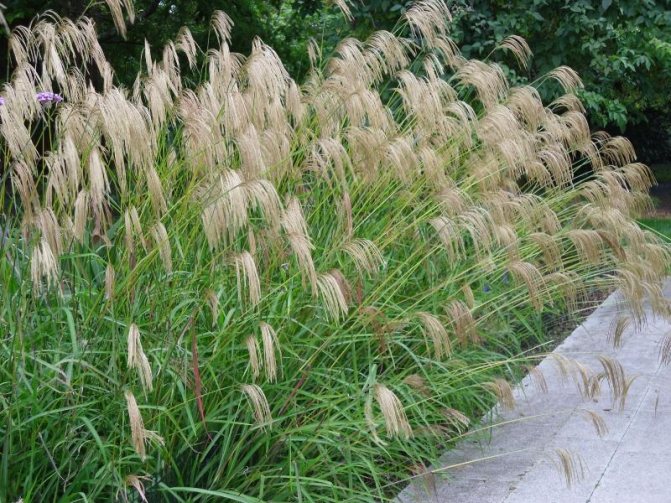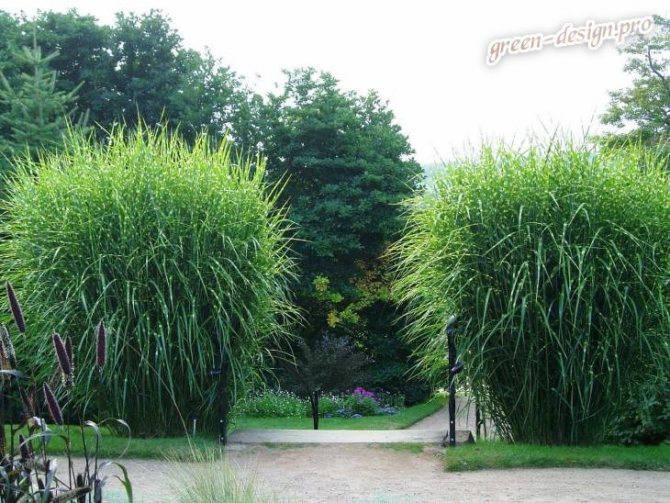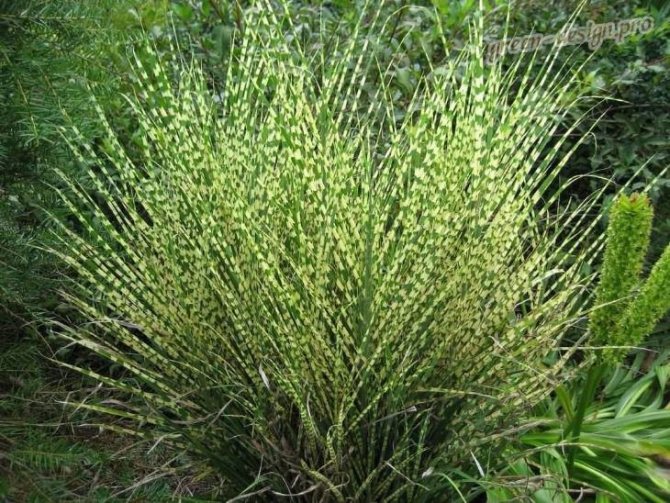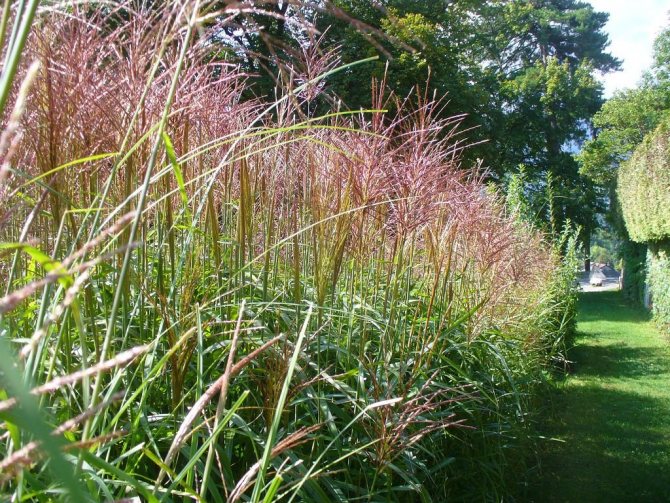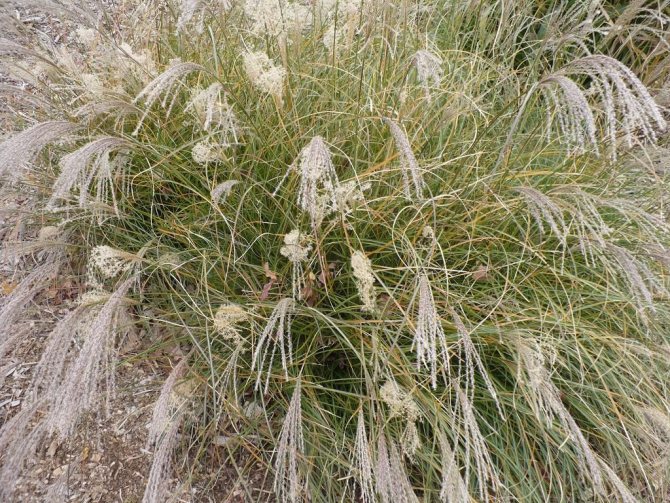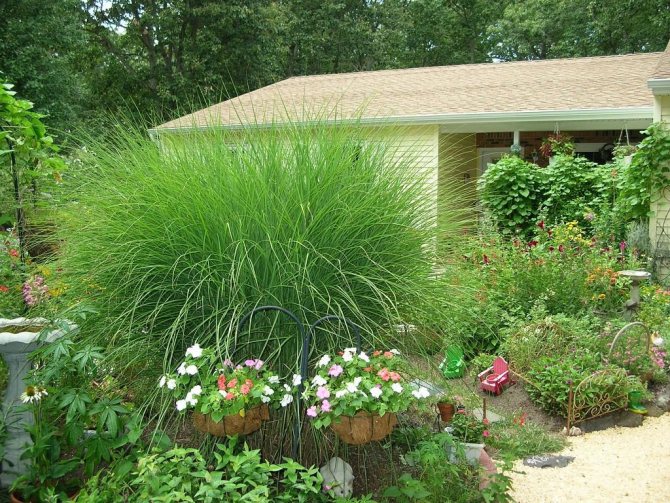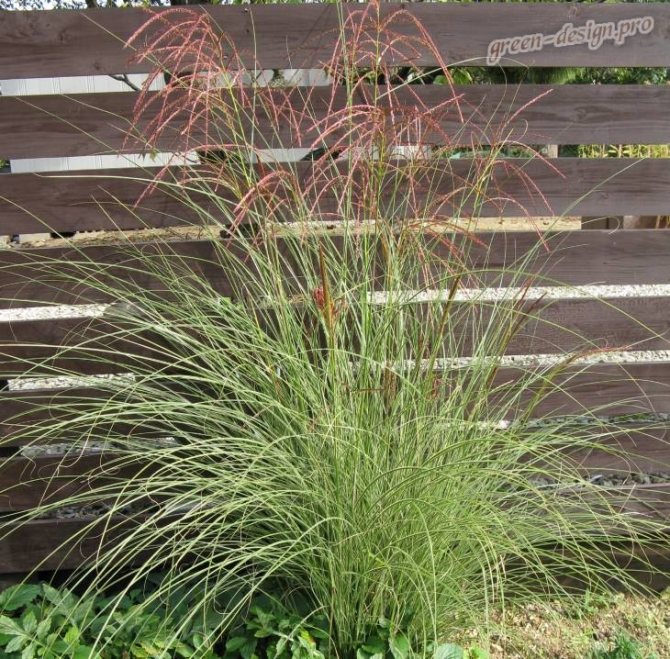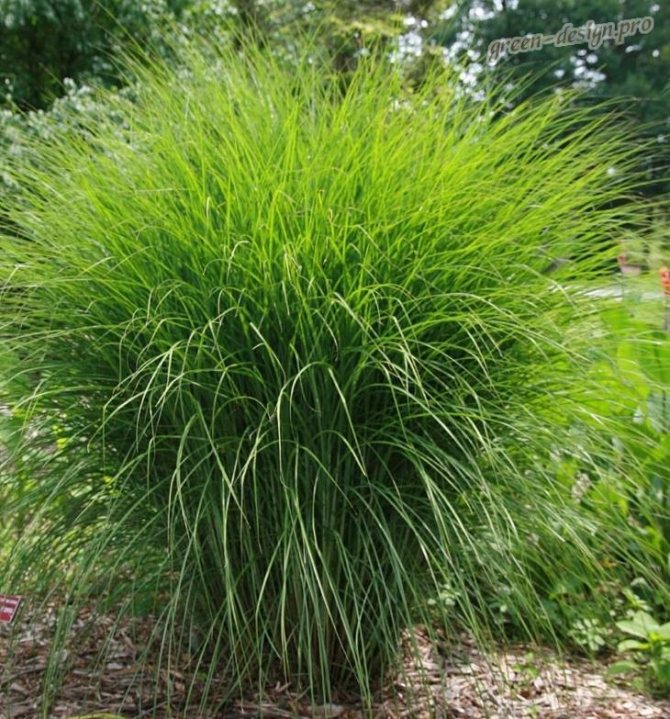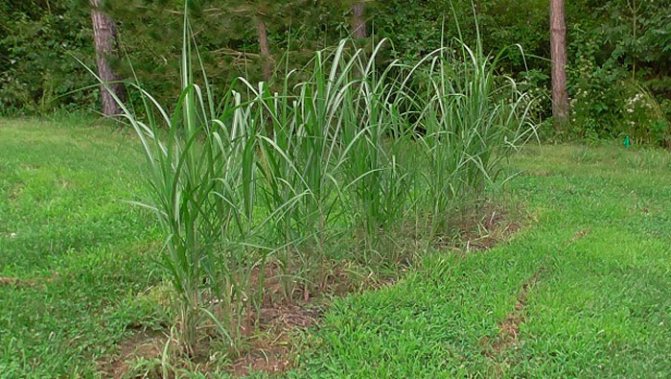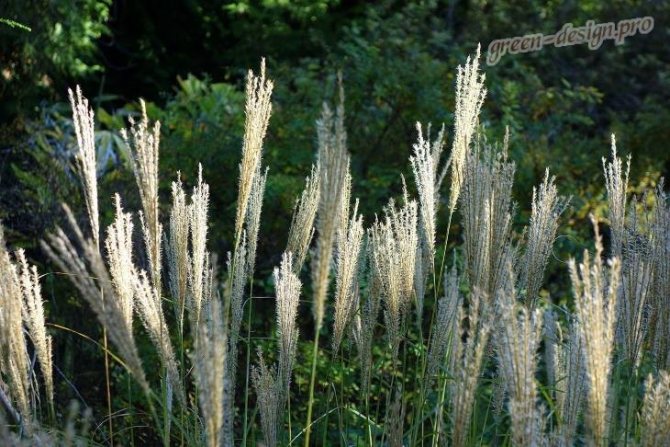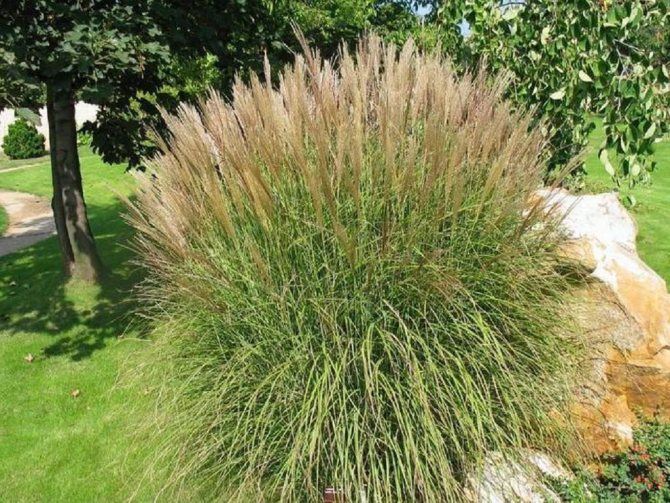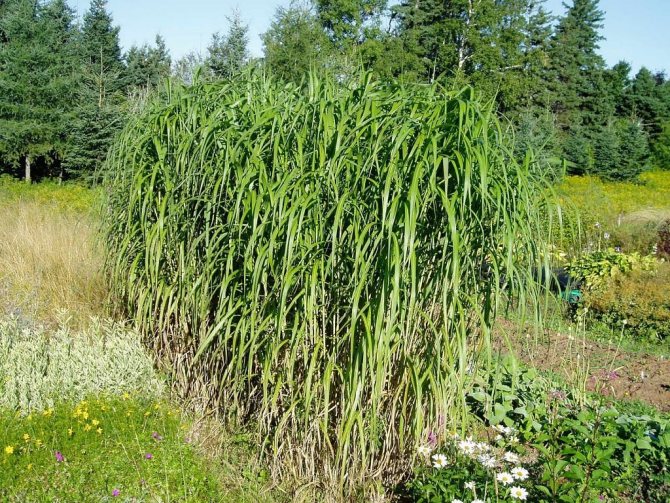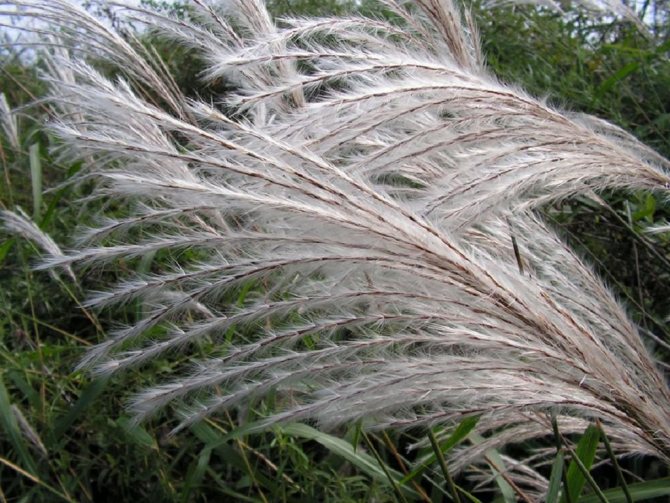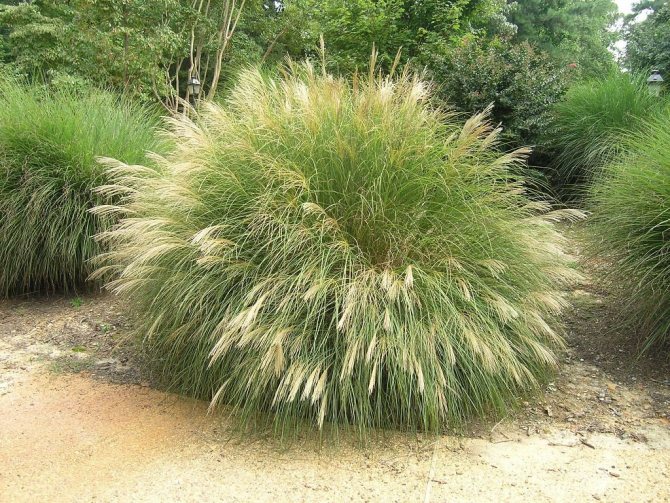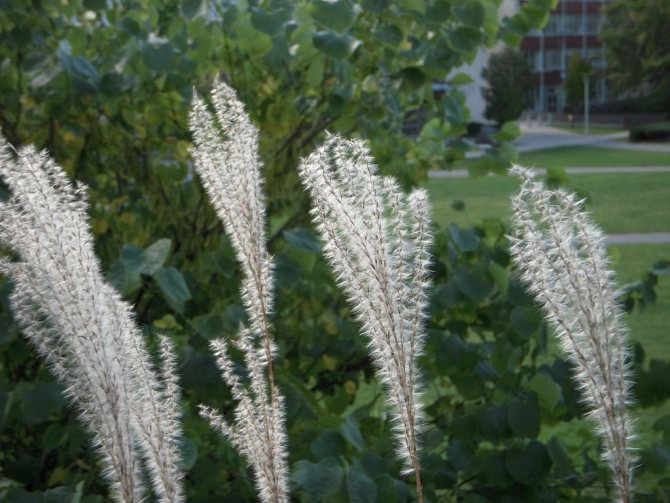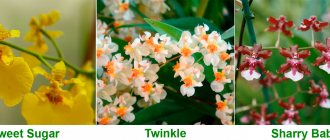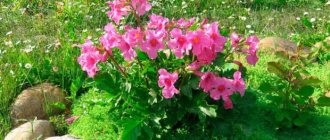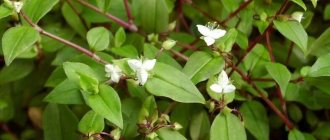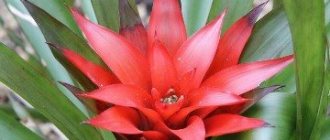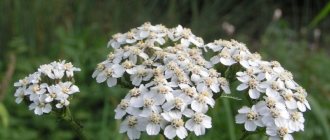Miscanthus, which is also called a fan, is closely related to sugar cane and is directly related to the genus of herbaceous perennial plants of the bluegrass family (cereals). Under natural conditions, such a plant can be found in the tropical and subtropical regions of Australia, Asia and Africa. This genus unites about 40 species. This decorative cereal is very popular among gardeners. In landscape design, lawns and decorative ponds are decorated with miscanthus, and this cereal is also indispensable for creating dry floristic compositions.
Description and options for using miscanthus in landscape design
Miscanthus is a fairly tall plant that grows up to 2 meters. Its characteristic feature is straight, rather tough stems and very long, narrow leaves. It grows in warm temperate zones on almost all continents. The genus miscanthus unites 40 species, which are successfully used in ornamental gardening. All of them belong to the Cereal family, so the plant is often called an ornamental cereal or fan for its characteristic appearance. Forms panicle inflorescences, which differ quite a lot in length in different species (from 10 to 30 cm). The ears themselves are small (within a centimeter), usually one full-fledged flower grows on them.
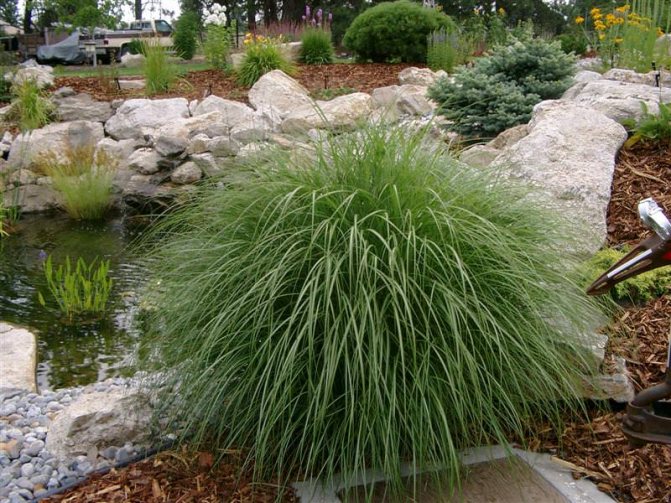
Since miscanthus in most cases grows well in width and forms tall erect stems with ears, it is used in landscape design in the following options:
- Creation of a green hedge from tall plant species - for this they are planted at a distance of at least 40-50 cm from each other. It is important to plant only 1 variety, as they will give the effect of a green wall with approximately the same height.
- It is very appropriate to plant tall miscanthuses by 1 bush in elevated areas or in the corners of the garden, since due to their large size they can emphasize the natural boundaries of the site or separate some plants from others.
- Low-growing miscanthuses are widely used to create borders along country paths - they are very lush, and thanks to this they are able to smooth out corners, sharp turns and create the effect of a real green carpet.
- Finally, a very good option is to plant tall miscanthuses along the summer cottage pond. With the help of this design move, you can create the effect of a real natural lake, along the banks of which a small forest grows.
About the plant
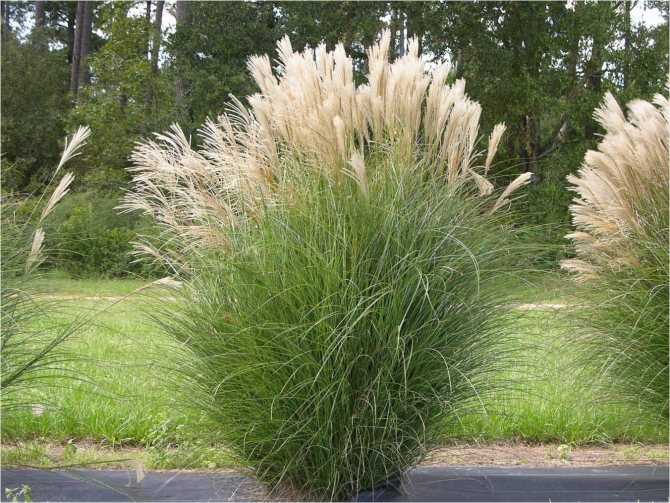

Miscanthus fan
The Miscanthus plant itself, or as it is also called Veernik, is considered one of the closest relatives of sugar cane. It belongs to the Myatlikov family, which are popular in tropical regions of Asia. In total, there are about 40 varieties of this plant.
Today it is believed that Miscanthus is most suitable for landscape design, which is used to decorate various reservoirs, lawns and other floristic compositions.
Characteristics and varieties of Chinese miscanthus
One of the most common species of this plant in Russia is the Chinese Miscanthus (often called the Chinese reed).Almost all of its varieties are frost-resistant enough, so they can often be found in the Far East, Eastern Siberia. It also grows in Japan, Korea and China, which is where its name comes from. There are quite a few varieties of this species, which are grown almost throughout the country.
Miscanthus Graziella
Unlike their brethren, this variety grows up to one and a half meters in height. Its inflorescences are superficially similar to white feathers, which look good when several bushes are planted in a row. It blooms at the very end of summer (if autumn is warm, then until October).
This variety is often used for planting in rockeries and along the edges of paths. Young plants especially need shelter for the winter, since the variety has an average winter hardiness. However, this variety is very resistant to pests and diseases.
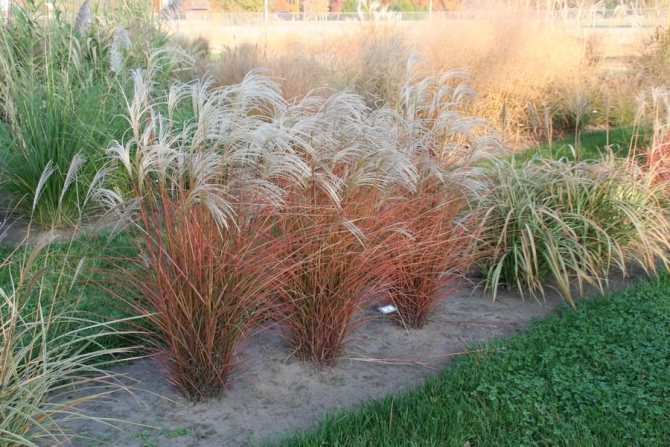

Miscanthus Cascade
This variety on the contrary is a real giant, he grows up to 3 meters in height. They are most often planted separately or along the perimeter of the garden, since otherwise they will grow strongly and hide other plants. At the beginning of flowering, the inflorescences acquire a pale pink color and hang down beautifully, then closer to the second half of summer they begin to fade. This variety is distinguished by a special love for moisture; the rate of growth largely depends on the quality of irrigation.
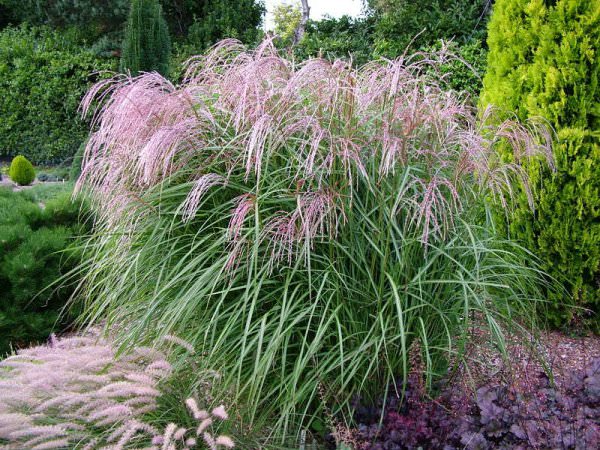

Miscanthus Zebrinus strictus
The zebrin variety is not inferior in height to the Cascade, but it does not develop so much in width (within 80-90 cm). Differs in flowers of red shades, which appear at the very end of summer and bloom all September. The variety also loves moisture very much, therefore, regular watering is essential for its successful growth. But in terms of winter hardiness, it is quite capricious and needs additional measures of insulation.
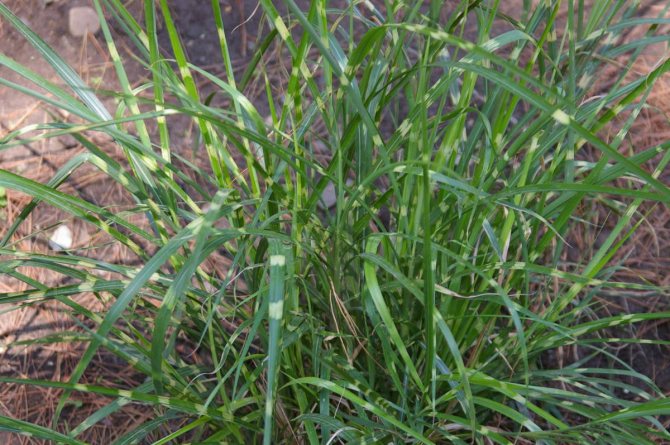

Other varieties
Among other varieties that have become widespread, Miscanthus gracilimus, blond, flamingo, silberfeder are known.
- Gracilimus differs in orange-copper color of inflorescences and weeping leaves, which turn yellow in autumn. The plant has a spherical shape and a great height (about 2 meters), due to which it is used in specimen plantings along the edges of the site or along its roads.
- Blondeau is characterized by sufficient frost resistance. Its inflorescences are creamy light shades, densely cover the ears. It also reaches a height of about 2 meters.
- Flamingo got its name from the beautiful flowers of pale pink tones. The variety is quite frost-resistant.
- Silberfeder has flowers of silvery shades that are very similar to feathers. The height of the stem with inflorescences can be up to 2 meters.
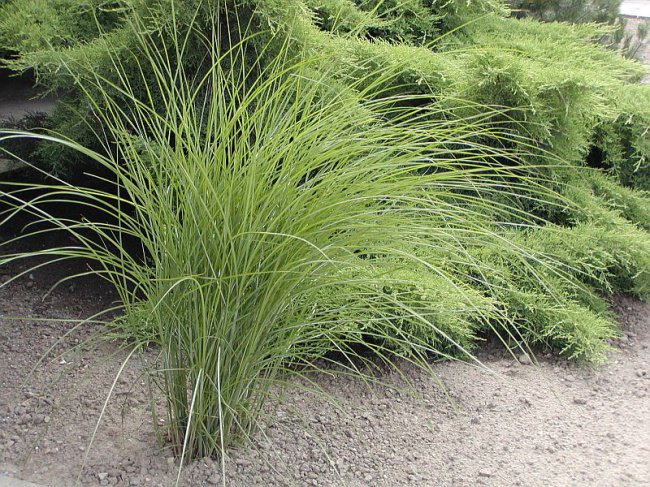

Miscanthus after flowering
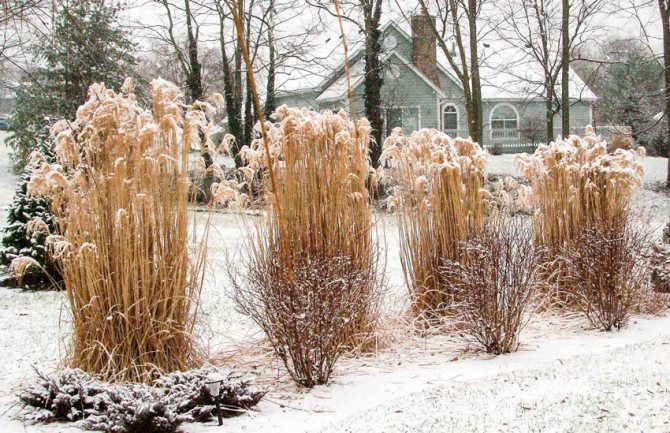

There are types of miscanthus that are frost-resistant, while others just need a good shelter for the winter. If you have planted a rather delicate variety of such an ornamental cereal, then you will have to provide it with protection from both frost and sudden temperature changes. In the event that it gradually gets colder outside, the cereal can have time to adapt, but if the frost is unexpected, then the bushes in most cases die. In order to protect such ornamental plants, it is necessary to cover the bushes with a film, placing it in a hut, while air must be supplied from the side parts under the shelter. Then, on top of the film, you need to install 2 wood shields in the same hut. However, before covering the miscanthus, it is necessary to cover the area where it grows with a very thick layer of mulch, which can be used as any loose soil.
Description of the giant miscanthus
The name of this variety exactly matches its size - up to 250-300 cm in height and up to 2 meters in width. This is one of the few miscanthus varieties that loves light shade - it can be planted in areas where the sun's rays do not enter open during the heat of the day.
Branches with flowers are weeping, rather strongly bend in an arc. When the flowers bloom, they have a pink hue, but quickly fade and turn to silver. It is profitable to plant such a variety alone., especially near a reservoir, over which it will beautifully spread its branches.
Reproduction methods
Miscanthus propagates by seeds and vegetatively. In February, mature seeds with a fluffy tuft are sown without pretreatment in peat pots with moist sandy-peat soil. Thin sprouts will appear in 1-2 weeks. Seedlings are kept in bright diffused light and room temperature. In April-May, when the soil is fully warmed up to + 20 ° C, miscanthus is planted in open ground. At first, only single thin blades of grass rise above the ground. A lush green bush forms by the end of 3-4 years after sowing.
It is more convenient to propagate adult miscanthus vegetatively - by dividing the bush. The advantage of this method is the preservation of highly decorative varietal traits. In the spring or in the first half of summer, the plants are dug up and disassembled with the hands of the curtains. Horizontal shoots are cut with a sharp blade. All manipulations must be carried out with great care, since the roots are easily damaged. The resulting cuttings are immediately planted in pits, deepening the root by 5-6 cm. During the month, the plants take root, so they need more frequent watering. Then the bush gives lateral shoots.
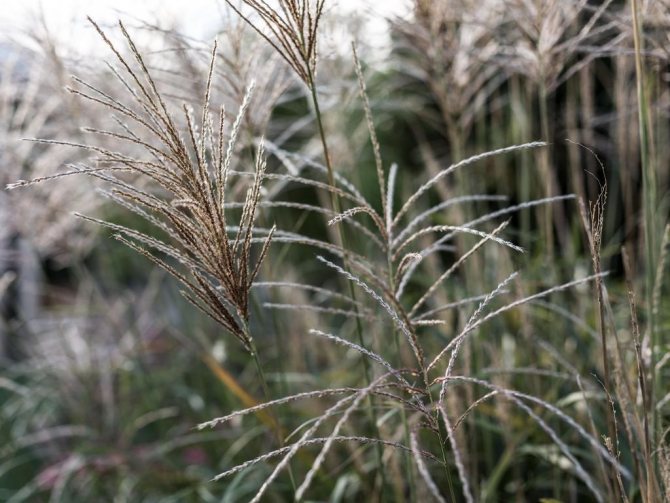

Planting miscanthus outdoors
In general, the fan is quite unpretentious to care for, but when planting a plant, several conditions must be taken into account in order to ensure sufficient growth rates already in the first season.
Site selection and preparation
The choice of a place for planting must be approached especially responsibly, since the plant is perennial and it is undesirable to move it. The place is selected in the open sun, since the fan is photophilous. Also the ground should not be dry - it is best to plant miscanthus near a reservoir or in a low place, where water will drain after rain. At the same time, it is not necessary to plant the grain and where the water constantly stagnates - moisture should be in moderation.
Important! The plant can be propagated by seed, but most often it is bred vegetatively. Moreover, in order for it to take root well, it is necessary that there are at least 6 shoots on the stem.


Planting technology and timing
Most often, planting of cereals (as well as transplanting) is carried out in mid-April, when the earth has already warmed up a little. In the climatic conditions of Russia, only already grown bushes (up to 30 cm) are planted, since otherwise there is a great risk that the fan will not have time to take root. Landing technology rules are simple:
- The depth of the pit should be between 30 and 50 cm, depending on the volume of the rhizomes of the plant itself.
- The hole should be noticeably wider than the root system of miscanthus - its roots love to grow in the ground.
- After planting, it is better to fill the hole not with the same soil, but with a layer of fertile soil.
- Water the seedling well immediately after planting.
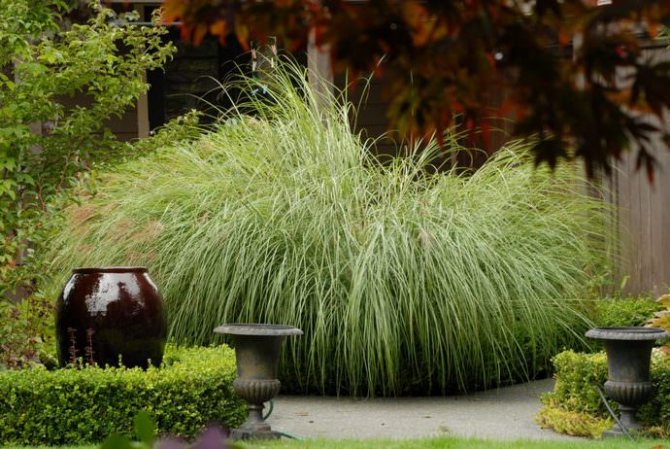

Description, variety of morphological characters
Plot owners sometimes prefer to see a riot of green spaces around, so they use miscanthus in their landscape design. Ornamental cereal is found in the wild in the tropical climate of Australia and Africa. Some varieties have successfully acclimatized to the frosty winters of our area. Miscanthus is a perennial grass, the height of which varies from 80 to 300 cm. An erect stem, linear leaves reaching half a meter, have a variety of colors:
- bright green;
- reddish;
- with transverse golden stripes;
- with transverse white stripes;
- with a white vein in the middle of the leaf.
By the beginning of autumn, the plant releases a panicle inflorescence on which spikelets are located. The inflorescence can have different colors depending on the variety:
- silvery;
- pink;
- red;
- yellowish.
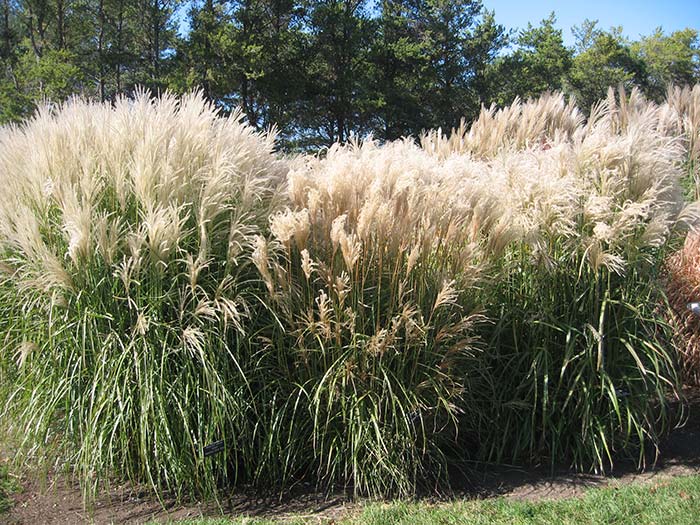

The plant is popular with landscape designers
The plant got its second name fannik for its unusual shape: an adult plant has dense foliage that resembles a fan, falling down like a green fountain.
Miscanthus care secrets
The fannyk grows for many years (up to 25-30) and does not need special care. However, it has several characteristics that make it very different from other plants. They are associated with the peculiarities of feeding and preparation for the winter period.
What plants to plant next to ornamental cereals
Since miscanthus is quite sprawling and tall, you should not plant it with other plants.
Watering and feeding the fan
The fannyk is quite hygrophilous, therefore, in dry times, it needs abundant watering. If the ground on the surface of the plant is dry to the touch, this is a clear sign of the need for watering. And dry cracked soil should not be allowed at all. You need to water in warm weather, at the same time, it is better not to allow water to get on the leaves - so they can be burned by the sun and dry quickly.
As for feeding, the fan has a feature that distinguishes it from many garden plants - in the first year he is not fed at all, and starting from the second season, small portions of nitrogen, potassium-phosphorus fertilizers are applied. From organic fertilizers, a weak urea solution is well suited. If you overfeed the soil, then the leaves of the cereal can lie on the ground.
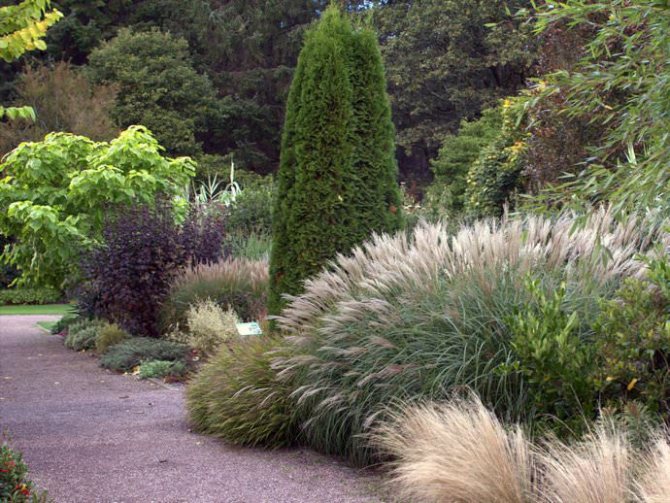

Disease prevention and pest control
Weeds like to settle near miscanthus, which take away water and nutrients from it. We need to prepare for the fact that in the first year or two, weeding the site will be a constant task. But starting from the age of 3, the roots and foliage grow so much that almost all weeds die due to the strong shade of the fan.
To prevent weeds from “strangling” young shoots, you need to treat the soil with special herbicide solutions at the very beginning of the season (April-May).
As for pests or diseases, the fan has a fairly strong immunity to them.... However, it is still necessary to treat the green with a solution of fungicides, since miscanthus is often affected by rust - a leaf disease that is provoked by fungal microorganisms.
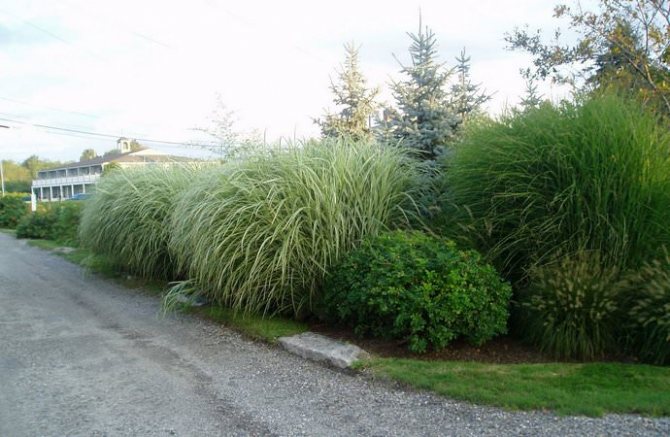

Preparing the plant for winter
Since the plant is found in the wild in warm places, in the conditions of the Russian winter, it needs additional protection from frost. This is especially true for varieties that do not have sufficient frost resistance.
In autumn, you need to especially monitor the weather forecast, since sharp frosts can destroy the roots of the plant. It is necessary to prepare it for the cold season in advance. To do this, you need to perform the following actions:
- Before starting work, you need to mulch the surface and put a rather thick layer of loose soil (it can be together with fallen leaves) - this way you can reliably protect the roots from freezing.
- Cover the plant with foil so that the overlap between the different fragments is at least 30 cm.
- Fasten the fragments of the film with a stapler, thread or tape.
- Place stones, bricks or any other solid objects on the base so that the wind cannot blow the structure.
Growing miscanthus from seeds
Sowing is done in the fall. Seeds do not need to undergo preliminary stratification, their step-by-step planting:
- Place 1-2 units of seed in separate small containers. Press lightly into the surface without deeply deepening.
- Cover with a plastic bag or glass to create a greenhouse effect.
- The shelter should be cleaned daily for watering and ventilation. Wipe off condensation from the walls. Keep the container with seedlings in a room with diffused light.
- Remove the film after emergence.
- Keep at + 19 ... + 21 ° С. With a short daylight hours, extend it with phytolamps. The soil should always be slightly damp.
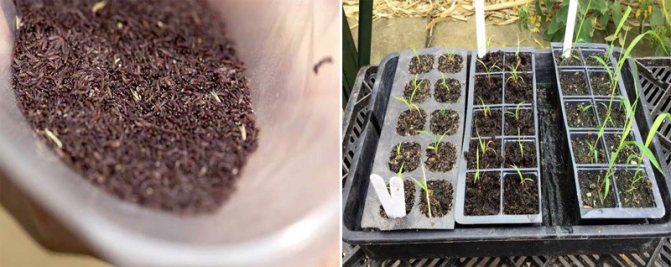

Growing miscanthus from seeds
Miscanthus: irrigation, fertilization, weed control


In order to grow a beautiful fan bush, you do not need to have special skills. It is enough to know the simple rules of care and follow them.
Propagation of miscanthus is best done by dividing the root system. The seed method is quite complicated and does not always give the desired result.
Growing by dividing a bush
It is easy to get a new plant from an old Miscanthus by dividing its bush into parts. Such division is performed no more often than once every three to four years, because miscanthus does not tolerate division well and takes a long time to recover. This procedure is recommended during the spring or summer months.
The bush must be dug out together with the rhizome so as not to damage the roots. Excess soil is cleaned from it. It is important that the root of the perennial is strong and has young stems. The rhizome should be divided with a sharp knife. Parts of the root are immediately planted in ready-made holes in a permanent place. If planting is not possible immediately, the roots can be stored in a cold room for several days. Plants obtained by dividing the rhizome undergo a long adaptation process.
Popular: The role of blunt bloodworm in landscaping a garden plot
Ready-made seedlings can also be purchased from a nursery or store. When buying, the gardener should carefully examine the condition of the seedling. The plant should not be sick, damaged. The soil in the flower pot must be free from signs of insect infestation.
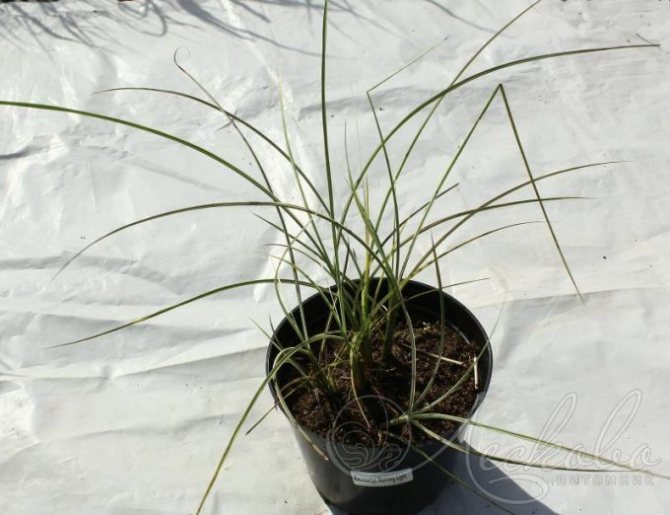

Winning option
Due to the high yield of dry biomass (up to 25 t / ha), high calorific value (5 kW / h / kg or 18 MJ / kg (pellets)), low natural moisture content of the harvested stems (up to 15%), Miscanthus gigantus is one of the most efficient plants for biofuel production compared to other crops. During the combustion of miscanthus gigantus biomass, less carbon dioxide is released than it was absorbed by plants during photosynthesis, therefore, the use of miscanthus gigantus biofuel will not contribute to the greenhouse effect. Its stems contain 64-71% cellulose, which provides a high energy value.
1 ton of fuel pellets from miscanthus gigantus is approximately equivalent to 440 kg of crude oil, 820 kg of coal, 515 m3 of natural gas, 1.2 tons of wood or 420 kg of diesel fuel.


Sugar-flowered miscanthus plant (sugar-flowered) and its photo
Miscanthus sucrose (Miscanthus sachariflorus (Maximi) Hack.). The family of cereals. Homeland - the Far East. Perennial and cereal. Stem up to 2 m high. Leaves are linear, panicle is wide, fan-shaped, white. Spikelets are surrounded by white silvery hairs. Propagated by seeds and division. Cut off the newly opened panicles and hang freely in a shaded place. When dry, they become fluffy, light and airy. For several years, the spikelets do not crumble, the panicles remain decorative. Several of these panicles in a dark vase will decorate the room.
See how beautiful miscanthus sucrose in the general bouquet of dried flowers:
Sugar-flowered miscanthus grows from May to September. It blooms in August, the seeds rarely ripen. But keep in mind, it is very aggressive and grows extremely fast. Knowing this, and in order to save space, gardeners place it in a large plastic pot and dig it into the middle of the compost heap. Quite somehow imperceptibly, its roots penetrate into the nutrient medium of the compost through holes in the bowl in one summer and occupy the entire space, creating a luxurious lush curtain. The compost heap turns into an exotic fairytale hill.
That is so, but now how to use compost for its intended purpose? To do this, you will have to get rid of a huge mass of hard roots by covering the entire compost heap with black agril, so that in the absence of sunlight, the miscanthus will peel along with the compost, and this will take at least three months. Therefore, we can conclude that the recommendations for containing the living space of such aggressors using different restraints such as curb tape or any bowls are ineffective.In the end, you will have to work hard to get rid of this plant, or somehow tame its predatory inclinations. But, in fairness, I must say that sugar-flowering miscanthuses are good in large areas for decorating reservoirs in a natural style, where there is no need to fight them and make any efforts to care for them.
How to plant
Miscanthus of any kind is unpretentious: zebrina, adagio - any species will not cause difficulties in planting and care. Absolutely not picky about the composition of the soil. Therefore, additional application of mineral and organic fertilizers is not required. Exceptions are non-black earth zones. In areas with too scarce soils, the soil from the planting pit is replaced with a mixture of compost and sod land.
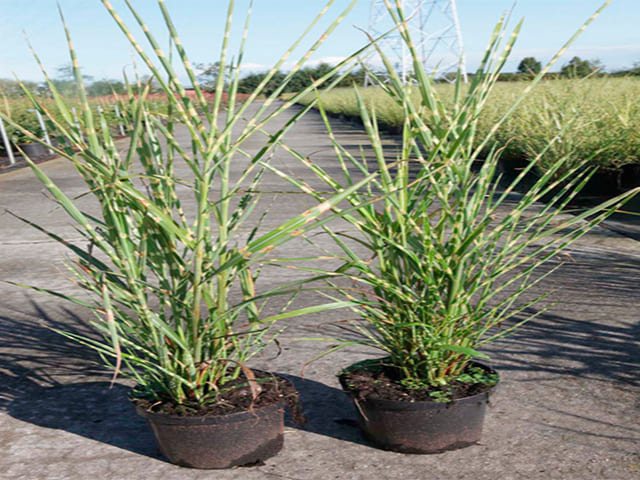

If you are the owner of an area with mainly heavy clay layers, then before planting miscanthus, do not forget to loosen them. To do this, add river sand, compost and humus to the planting pit. If you use peat as a baking powder, keep an eye on the acidity of the soil. A too high pH value negatively affects the growth of seedlings.
When planting varieties from China, the growth restrictor for the root system does not need to be equipped. If you plan to plant a sugar-colored variety, then a rigid, closed loop around the planting site is a necessity. Flat slate is the ideal material for creating a constraint. Such material does not deteriorate under the influence of an aggressive environment, and retains its integrity for a long time. The depth of immersion in the soil of slate sheets is about 15 - 20 cm, and the elevation above the ground surface is 10 - 15 cm.
Some growers plant miscanthus in bottomless buckets. This method does not allow him to creep over the site, and if necessary, you can easily and quickly transplant without injuring the root system.
Care features: watering, feeding
An adult plant does not require special care. It is enough to monitor the soil moisture and timely fertilize. It is advisable to apply fertilizers twice a year: the first time in the spring, the second in the fall. Spring feeding should consist of nitrogenous fertilizers that promote the growth of green mass. In the fall, potash or phosphorus fertilizers are applied. Fannik is a tropical plant, which means it constantly needs watering. In hot weather, watering should be abundant; when dry, the plant will lose its decorative effect. Young plants obtained from seeds will require more careful maintenance.
- After planting in open ground, it is necessary to monitor the soil moisture.
- Remove weeds from the plant.
- The soil around the miscanthus must be loosened.
- For the winter, the root system of a young seedling requires additional insulation. To do this, cover the soil with dry leaves or other covering material.
- It is necessary to insulate the shoots. Use fabric insulation.
- Fertilize in the spring and fall.
Growing conditions on a personal plot
The plant should be placed in sunny places, protected from strong winds. If the bush is planted in a ventilated area, the delicate leaves will take on a frayed, sloppy look. A good option would be to place the cereal near buildings, large bushes or on a slope with a sunny and calm side.
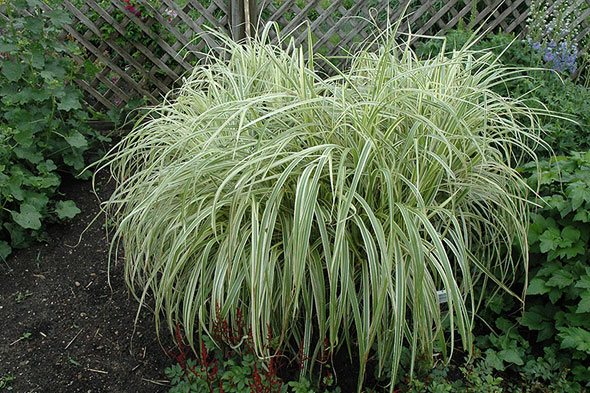

Miscanthus loves moisture; a good solution would be to plant it along the banks of reservoirs. The composition of the soil does not matter much, the main thing is good moisture capacity. It can grow in poor soils. Clay soils are ennobled by adding sand and gravel.
Diseases and pests
Miscanthus has strong immunity against diseases and rarely succumbs to pests. But if this happens, then one of the following insects affects the plant:
- Spider mite - it multiplies quickly and affects a large area. Additionally, the pest can infect the crop with gray rot, since it is the carrier of its spores.A symptom of the appearance of a tick is a thin, whitish cobweb. Akarin, Kleschevit and other insecticides will help against the pest.
- Scabbard - quickly drinks juices from the plant. If nothing is done in time, then miscanthus cannot be saved. Signs of damage - yellowing leaves, which gradually disappear, then the culture dies off entirely.
- May beetle - insect larvae pose a danger to miscanthus. They like the taste of the rhizome.
- Scoop - caterpillar eats roots and ground part of the culture.
If pests are found on the crop, immediately treat it with insecticides. Of the diseases, only root rot affects the plant.
Miscanthus is distinguished by its unpretentiousness and disease resistance. He will add variety and originality to your site.
Testimonials
Ekaterina: “I took Miscanthus from a friend, it has been growing with me for the third year already. Unpretentious, but appreciates water and fertilizers. "
Evgeniy: “In the Moscow region, Chinese miscanthus has been growing for about 12 years, blooming in August-September with silvery panicles. It tolerates winter well and did not freeze even in snowless conditions. "
Elena: “I have been growing the Stritus variety for almost 4 years, and I really like it. The bush is compact, does not sprawl and retains its beauty even in winter. Dry panicles also last very long and look good. "
Landing
It will be correct to plant miscanthus in the spring, in the second half of March you can start this process, and it ends in May. This plant loves the sun and warmth, therefore, it must be planted in an open area. True, these plants do not like drafts, which must be taken into account when choosing a place for the future decoration of the territory. The most important thing for a plant is water, without which it cannot survive and grow and develop normally. Miscanthus sits down with the help of seedlings, which are recommended to be dug in by adults, because this plant has a long period of development. A hole for the future plant is dug in relation to its root system, so that it is slightly larger than the roots. Fertile soil should be poured into the pit, after which a seedling can be placed in it. Cover the contents of the pit with earth, tamping it in the process. After the plant is planted, it needs to be watered properly.


IMG_6425
Popular traveler
Miscanthus has long been known on three continents - Asia, Africa and Australia, but it came to Europe in the early 1900s. His finest hour came only centuries later, when the issue of energy dependence became very acute. Then the plant was recognized as a revolutionary crop as a raw material for the production of biofuels, as well as for the production of energy by direct combustion.
Now miscanthus gigantus is grown and processed for sale in the form of pellets or briquettes in many European countries: Austria, Denmark, France, Germany, Hungary, Poland, Sweden, Great Britain and others. Moreover, the area under this culture is constantly increasing. For example, in the UK, since 2006, the cultivation of miscanthus has grown to several thousand hectares.
Experts from the National Bioenergy Union, who studied miscanthus, claim that if 10% of the fields in Europe are laid with this miraculous plant, you can additionally receive, in case of its combustion, up to 9% of electricity. By the way, the Common Agricultural Policy of the EU obliges farmers who own more than 15 hectares of arable land to allocate at least 5% of the area - such as buffer strips, landscape elements, land for afforestation and others - to grow perennial energy crops without using pesticides and chemicals. fertilizers, or keep their use to a minimum. In 2019, the share of land designated for environmental needs may grow to 7%. It is predicted that by 2020 the area of land available for growing energy crops may grow to 20.5 million hectares, and by 2030 - to 26.2 million hectares.
The EU provides for investment support for the establishment of energy crop plantations. In addition to the pan-European regulatory mechanisms, many EU countries have their own instruments to stimulate farmers - subsidies for the cultivation and creation of fast-growing forest plantations, high prices for biomass, a developed biofuel market, and the like.
Preparation for wintering
In the fall, the fan needs to be prepared for the onset of cold weather.
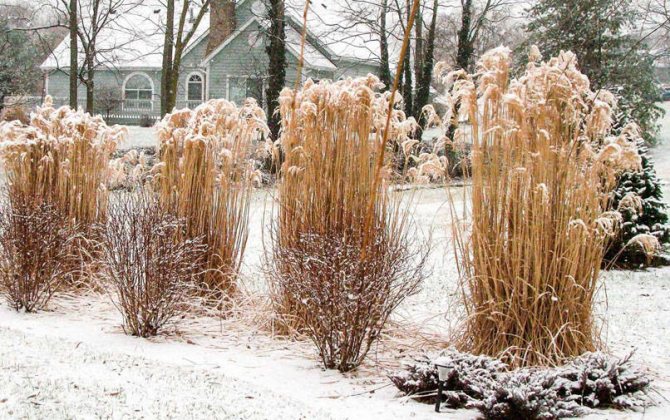

This will give the plant a better chance of tolerating the cold.
The ground around the plant is insulated.
For this, hay, straw, dry leaves are used.
It is not necessary to cut off the above-ground part, because the stems serve as insulation, they keep the snow.
With the onset of spring, the stems are cut. This will help young shoots appear, they will develop faster.

